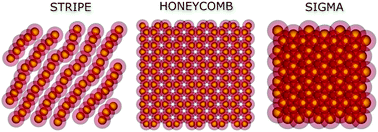On the formation of stripe, sigma, and honeycomb phases in a core–corona system
Abstract
Using Monte Carlo simulations and free-energy calculations, we investigate the phase behaviour of a two-dimensional core–corona system. We model this system as particles consisting of an impenetrable hard core of diameter σHD surrounded by a purely repulsive soft corona of diameter δ = 1.95σHD. At low densities, we observe the spontaneous formation of a phase with a stripe texture as well as a honeycomb-like phase driven by both energy and entropy considerations. At high densities, we find that a two-dimensional analogue of the periodic sigma phase, considered as an approximant of dodecagonal quasicrystals, is energetically stabilised with respect to two distinct dodecagonal quasicrystals, namely, a square-triangle tiling and a square-triangle-shield tiling. We also find the formation of stable hexagonal phases at three distinct density ranges, which are energetically driven, i.e. by minimising the overlap of coronas. Furthermore, our calculations show that the low-density dodecagonal quasicrystal that was previously reported by Dotera et al., [Nature, 2014, 506, 208] is kinetically formed in the coexistence region between the honeycomb and the medium-density hexagonal phase.



 Please wait while we load your content...
Please wait while we load your content...